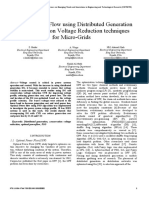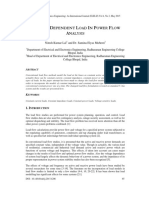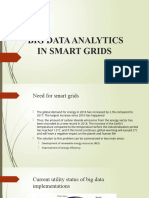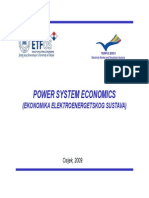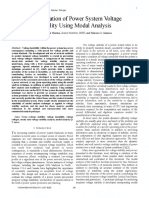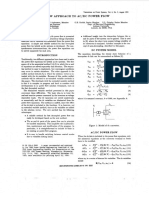Optimal Power Flows: J Carpentier
Uploaded by
soumyanitcOptimal Power Flows: J Carpentier
Uploaded by
soumyanitcOptimal power flows
J Carpentier
Electricit& de France, 3 Rue de Messine, 75008 Paris, France
The state of the art o f optimal power flows at the end o f appear on the market and these will certainly make a
19 78 is reviewed. The different aspects of the problem contribution in reducing the gap existing between theory
statement are established in the most complete way possible; and real time applications for optimal power flows. The
then methods for the solution of the static optimization are author hopes that this paper may help in putting researchers
presented and filed, with a brief description of the most in closer contact and in putting theory closer to real time
typical ones, trying to show the respective merits o f each applications.
family, and with a discussion o f points o f special interest.
Finally, dynamic aspects with applications to online
dispatch are investigated. II. Statement of the problem
II. 1 Preliminary assumptions
I. I n t r o d u c t i o n Before stating the problem, we assume that
Before tile introduction of optimal load flows, so-called
'economic dispatch' was used to determine the best way to • thermal generating units were committed (nuclear units
share the real load between several generating thermal units being included among thermal units)
having a total capacity greater than the generation required.
Everything was as simple as in paradise : losses were taken • hydroelectric plant real generations were fixed
into account through B coefficients, control orders were sent
directly to the units and nothing happened but savings. • the transmission network was defined, at least pro-
The trouble started around 1961 when the use of networks visionally.
close to their limits led to a fear of line overloadings; security
constraints had to be introduced and optimal power flows 11.2 Physical control variables
were rapidly born. Instead of a 'compact' model consisting In order to find the best operation within the constraints
of one equation with real powers only, it appeared necessary imposed, the following variables are employed:
to consider all the variables defining the state of the system
and to solve the economic dispatch and the load flow (1) real generated powers of the thermal generating
problems at the same time. An optimal power flow may units
thus be dethaed as the determination of the complete state (2) voltages (or reactive generated powers) of the
of a power system corresponding to the best operation thermal and hydroelectric units and of the synchronous
within security constraints. Best operation usually means compensators
least fuel cost: security may range from the generation (3) variable transformer tap ratios for voltage magni-
feasibility up to very sophisticated constraints, so that the tude and for phase shifts if any
optimization problem may become huge. (4) other variable reactive power sources such as
capacitors and reactances
Since 1961, a number of optimal power flow computation (5) in special conditions, hydropower, emergency
methods have been proposed. In this paper, after presenting start-up, load shedding and even network structure changes
various possible statements of the problem, our aim is to
point out the most typical methods, as they appear today As a rule, we shall call these variables the 'control variables'
with a thought towards their possible usefulness, and bearing of the problem. In general, only variables (1), (2) and (3)
in mind that omissions are always possible. Except for a few are considered. Let us call:
papers, the author compelled himself to read (or re-read)
each paper mentioned in the references; so, please, forgive 'complete' or 'real-reactive' optimal power flow a
him if the list is too limited. Complements to references problem with the variables (1), (2) and (3) and possibly
may be found in the excellent survey on optimal power (4) and (5)
dispatch carried out by Happ 6s a few years ago.
'real' optimal power flow, the suboptimization problem
The author found writing this review very exciting for two with the real variables (1) only, the variables (2), (3) and
reasons: first, looking at 15 years' work corroborated his (4) being fixed and (5) possible,
opinion that sometimes there exist barriers between
countries -- researchers from one country working on 'reactive' or 'reactive only' optimal power flow, the
subjects solved and published elsewhere five or ten years suboptimization problem with the reactive variables
before; secondly, the revolution in computer hardware (2) and (3) [(4) possible], the variables (1) being settled
means that cheap, fast and powerful computers will soon (except at the slack bus to meet the real power balance).
Vol 1 No 1 April 1979 0142-0615/79/010003-13 $2.00 © 1979 IPC Business Press 3
11.3 Objective function 1978 lasted only about 3 h but caused a loss of production
The 'best operation' consists, in most cases, of minimizing for the country estimated to be at least the equivalent of
the real production cost F corresponding to the fuel cost 50 years' savings through economic dispatch.
directly due to power generation, excluding no load,
start-up and shut-down costs. As a rule, F is a polynomial This point leads us to two important questions concerning
in output power, P, usually of degree less than or equal to 3 the problem statement: discussion of the n - 1 security and
and often represented by a piecewise linear function. the overconstrained cases. A n-1 (or n-k) security con-
straint must be met only if dropping it would cause a
In special cases, an environmental cost function replaces general breakdown or at least a sufficient amount of non-
the fuel cost function or is mixed with it; load curtailment delivered power. The 'overconstrained case' happens when,
may also be minimized in some emergency cases. due to constraints, an optimal power flow has no possible
solution using conventional variables of types (1) to (4).
The considerations above are valuable for the complete and
Then, it is necessary to use a special process, with type (5)
real problems. In the reactive only problem, the losses are
variables, such as load shedding or changes in the network
usually minimized, but more sophisticated objective func-
structure.
tions may sometimes be considered.
11.4 Security 11.5 Extensions of the statement for static optimization
In the static optimization considered so far, extensions to
Security requirements are such that the operation is possible
special cases or refinements may sometimes be present in
for generating units, transmission lines, transformers and
the problem statement, e.g.:
customers - first when the system remains intact, and
secondly under contingency conditions, i.e. when one or
• valve point loading
several elements of the system suddenly trip. According to
Dy Liacco 2s,38 the words feasible and secure have been
• sparse generating capacity
used in the past for the two cases just mentioned. Since
the English vocabulary appears to have changed in recent
• environmental considerations
years, here we shall use the usual French designations:
• corona losses
• when operation is possible for the intact system, we shall
say 'n security' is met
• HDVC lines
when operation is possible for the system under contin-
• multiarea operation optimization
gency, with k elements tripped (k ~> 1), we shall say
'n-k security' is met. Contingencies are usually limited
11.6 Dynamic despatch and control
to the loss of 1 element, which corresponds to the case
Optimal power flows are of basic importance for long-range
of the ' n - I security'
planning and daily scheduling, but their final purpose is
real-time secure and optimal operation. In static optimiza-
These labels have the merit of being short and accurate.
tion, real and reactive loads are the given quantities. In real
n - 1 security (and sometimes n - k ) must be considered
time, loads change, giving a dynamic aspect to the problem.
because the sudden trip of an element may always occur
before any corrective action. Security involves meeting the Three ways of solving this problem may be given, in order
inequalities linking the control variables of the problems. of increasing refinement:
A list of the most common security inequalities encoun-
tere?, in optimal power flows is given below (n or n - k in (1) Perform static optimal power flows periodically and
brackets indicate the corresponding degree of security): use the usual control devices. This process presents an
important drawback: without any addition, frequency
• limits on the real power output P of a generator (n) control (or classical B coefficient dispatch) are inconsistent
with the matching of line flow constraints. Similarly existing
• limits on the reactive power output Q of a generator (n) or planned voltage secondary regulations do not seem to
meet the reactive constraints.
• limits on a function of these two quantities (e.g.
p2 + O2)(n) (2) Perform static optimal power flow periodically and
compute a by-product as 'participation factors' allowing
• limits on transformer tap ratios (n) control devices to meet the constraints; this corresponds
to following a foreseen trajectory for the loads. This
• limits on bus voltages (n) process represents progress but does not allow for unforeseen
changes in the loads.
• limits on currents, apparent power, real power or the
phase difference through a line or a transformer (n and (3) Perform static optimal power flows periodically and
n - 1, sometimes n - 2 ) compute a by-product allowing control devices to meet
• limits on the generator voltages just after contingency, the constraints corresponding to the actual loads. The
especially when a generator has tripped ( n - l ) latter process is not classical. We shall see later that a whole
family of optimal power flow solutions gives the elements
The major objective of security requirements is to avoid necessary to build the by-product. Processes (2) and (3)
a general failure in the system, the cost of which is con- correspond to two statements of the 'dynamic optimal
siderable: e.g. in France, the general failure of 19 December power flow'.
4 Electrical Power & Energy Systems
III. General features of the solutions Pi sum of the generated real powers at bus i,
if any
II I. 1 Some historical breakthroughs
Qi sum of the generated reactive powers at bus i,
The history of optimal power flows may be followed in the
if any
references, which are arranged in chronological order. For
Ci real load at bus i
optimal power flows, fundamental prehistory corresponds
Di reactive load at bus i
to economic dispatch, a basic synthesis of which was given
Ii real power injection at bus i = Pi - - C i
by Kirchmayer 2 in 1958. Security was not taken into
account, as also in the work of Squires 4 which certainly Ki reactive power injection at bus i = Qi - Di
was the first attempt to solve load flow and economic Pik real power generated at bus is given by the
dispatch at the same time. In 1962, n security appeared generator k (actual or fictitious for piecewise
in a fundamental work from the present author, the so- linearization)
called 'injections method 's was introduced, where the C sum of the real loads of the system
optimal power flow problem with security was stated, Ri 'reactive generalized injection' in i, used in a
optimality relations established and solved by a fairly crude load flow process. R i may be equal to Vt or K i
= Q i - O i o r t o another quantity when men-
method.
tioned
Then, after some years of little activity, 1968 saw the T subscript for 'transposed'. Usually vectors
arrival of four new important methods, appearing simul- without T will be column vectors
taneously: the Dommel and Tinney reduced gradient V column vector with N r o w s Vi: same definition
method12; the Sasson Hessian method13; the Wells linear for all the variables above with index i
programming method H and the author's differential injec-
tions method 14 using the generalized reduced gradient. The E = W= ,J = = = Jacobian (2N x 2N)
basic new concepts contained in these methods are still ' ~E J'" J'
valuable today and, to the author's knowledge, the decade p = p(W) = p(E) Total real losses of the system
following was mainly dedicated to improvements both on Z, Z m, Z M Variable, minimal and maximal corresponding
the theoretical and practical sides, the application of the values
optimal power flow in real time being undertaken now. AZ variation of Z
~21 constrained quantity in the line or trans-
111.2 Method families former 1 for the intact system; basically the
Among the various solutions reviewed, the main difference current;when mentioned, apparent or real
appears to be the 'compactness' of the method. We shall power flow, or phase angle difference
say a method is 'compact' if, directly or as a by-nroduct, it g2~ value of f21 after the element d of the system
provides a model of the system expressed only versus the tripped
(physical) control variables defined in the problem state- T1 upper limit for ~ 1
ment, with security inequalities, if any, all being included T'1 upper limit for g2d (usually f2d > ~~l)
in the model. Thus, the classic economic despatch is com- pg variable transformer tap ratio, for voltage
pact. Hessian and Dommel Tinney reduced gradient are magnitude
noncompact, since their system models use all the variables. ok variable transformer tap ratio, for phase shift
Compactness generally involves greater complexity but u vector of the (physical) control variables of
allows wider applications. the system (here control ~ independent)
Starting from this viewpoint, we shall review in turn: x vector of the state variables of the system,
defined as the variables different from the
• classic economic dispatch control variables (here state * dependent)
• general static optimization noncompact methods X:[~] vector of the variables of the system (whole set)
F = F(X) = F(x, u) objective function, usually operation
• general static optimization compact methods
total fuel cost
Peculiar aspects of static optimization methods are then g(JO = 0= 0 tj (physical) load flow equations
g(x, u)
investigated:
h(X) ~< 0 }
h(x, u) <~0 set of inequality constraints
• special purpose extensions
L Lagrangian function
• discussion of the n - 1 security
IV. General static optimization methods I: classic
• overconstrained cases
economic dispatch
The classic economic dispatch 2 is limited to real optimiza-
Finally dynamic optimal load flows and control will be tion, taking losses into account, without security and with
considered. a dynamic character. Its formulation is compact.
111.3 Main notations and symbols It is based upon the property that the control variables of
We shall use the following notations and symbols: a system are linked by a single equation, the real po~er
balance, so that the problem is written:
i ~ [0, NI bus number; 0 refers to the slack bus
Vi voltage magnitude at bus i Min F(P) = ~ Fi(Pi) (1)
Oi voltage phase angle at bus i i
Vol 1 No 1 April 1979 5
with suited to accept constraints as tile compact methods and
are not really practical for extension to real tinre operation.
~ Pi = C + p(P) (2)
i
V.2 Direct Kuhn and Tucker methods
In these methods, the optimality conditions are established
Basically, by a separate computation, tile losses p are
through the Kuhn and Tucker theorem and solved directly
expressed versus the generated real powers Pi using a quad-
(whereas in all the other methods the gradient criterion is
ratic formula p = p(P) such as:
used). The earliest was the "injections' method.
~}p
- - = 2 E BliP/+ B° (3) V.2.1 Injections method. In tile early sixties, the following
aPi i problem was presented by the author:
Lagrange's method gives the optimality conditions: Minimize F(P) under the R)llowing constraints:
d L = 0 with L = F ( P ) - X(~/Pi -P C) (6)
li(O, V) Pi + Ci : 0 i physical load flow or
Ki(O , V) Qi + Di : 0 i 'injections' relations, V i (7)
which gives:
aF/a& (s)
- ?, = constant (4)
l - (~p/~iPi)
Q~" ~ Qi <~Q~4 for every generating bus (9)
Equations (4) are the so-called 'coordination equations'
which are straightforward to solve taking (3) into account.
# <s, (10)
The B coefficients are computed using various approxima- (Jl)
vF' < v, v v i
tions and may be employed over a very wide region, a few
sets of coefficients being sufficient for all kinds of opera-
0i 0/~< T0 l\)r any couple i, / of (]2)
tions.
neighbouring buses
The method clearly allows dynamic dispatch, which is
a very important quality and is certainly the main reason This is one general statement of the n security real reactive
for its extensive use. Various improvements and extensions complete optimal power flow problem.
have been carried out, such as:
Tile optimality conditions were found using the Kuhn and
• extension to multiarea economic dispatch 3,24,6s Tucker theorem. These conditions are well known: the
reader may find them in English in ref 65.
• improvements in the computat,ons of tile loss quadratic
formula 10 The numerical solution was obtained by attempting
to meet the optimality conditions by a try and check
direct computation of the 'first order differential !osses' algorithm based upon the values of the dual variables
OP/~Pi as proposed by Happ 48 by the transposed appearing in the conditions. As this numerical nrethod was
Jacobian: elaborated in 1961, a relaxation process was used (matrix
sparsity, triangularization and Newton's method were used
a# in France only one year later "7,s). Compared to present-day
Op _ j T I __ (5) algorithms, file process was slow and had convergence
OP O0
difficulties in some heavily constrained cases.
The main drawback of this simple method is the absence
Interesting by-products were found in the l'ornl of dual
of security: this concept is now introduced.
variables, e.g. ~.i = OF/OCi and ,I/i aF/~Di, incremental
=
values of the real and reactive delivered powers at the bus i.
V. General static optimization methods I1: non- This is the reason (in addition to the dual character of the
compact secure optimal power flow methods algorithm) why one of the corresponding programs is still
in use in France for capacitor localization planning studies
v. 1 General characteristics in large scale networks.
The problem statement includes inequalities, so that
Lagrange's method is theoretically no longer applicable; V.2.2 Other methods. The main quality of the algorithm
the conditions for optimality must come either from the associated with the Injections method was to exist. Progress
application of the theorem of Kuhn and Tucker I or from occurred later, Shen and Laughton iv being most successful
putting the projected gradient of a convenient function when they generalized the statement introducing transformer
equal to zero. The noncompact methods apply these pro- tap settings (voltage magnitude and phase shifts) and apparent
cesses directly to a system model including the whole set power flows through the lines, and used Newton's method
of variables, without building an intermediate 'reduced in the algorithm.
model' limited to the control variables u. They are in
general relatively easy to program and may exhibit high It seems to be a general property of naethods of this family
performance often due to the sparsity of the physical load that even frmn a purely practical point of view, it is always
flow equations. However, they are generally not so well difficult to guarantee convergence a priori.
6 Electrical Power & Energy Systems
V.3 Sasson Hessian methods h(x, u) <~ 0 including x ('functional constraints') are taken
V.3.1 Principle. In these methods, which are able to handle into account through penalty functions so that an artificial
the complete real reactive problem, network equations cost function f(x, u) is produced such as:
g(X) = 0 and the inequality constraints h(X) <~ 0 are taken
into account through penalty functions. A new objective f i x , u) = F(x, u) + rrh2(x, u) (is)
function C(X) is built up, such as:
Then,f(x, u) must be minimized subject to the load flow
C(X) = F(X) + rTg2(X) + s r h 2 ( X ) (13) equations g(x, u) = 0. Applying Lagrange's method gives
dL = 0 with L(x, u) = f ( x , u) + kTg(x, U) (XT row vector):
r T and ST are penalty coefficient row vectors, s K being 0 if
h K ( X ) < --eK, with eK small and positive. ~3L_0f+[~3g'] k=0 (16)
Then, let G(X) be the gradient d C / d X and H(X) the Hessian
ax ax l a x l r
dZG/dX 2 of C(X). With convenient values for r and s, the
constrained optimum is reached for G(hr) = 0. This point - + ~, = 0 (17)
is approached with a quadratic-type accuracy changing X 0u 0u 7-
by AX, such as
0L
H(X) A X = C(X) (14) --=g(x,u) = 0 (18)
0k
G is sparse and H is still sparse, which may allow relatively Differentiating g(x, u) = 0, it is easy to show that OL/Ou
fast computations. is the reduced gradient V f o f f versus u considered as inde-
pendent variables, i.e. d f = Vfrdu. So, the basic minimiza-
V.3.2 Practical aspects and improvements. The first research
tion algorithm, for n security only, is as follows:
in this field was performed by Sasson 13,18,19 and Cory 29,33
using the Fletcher and Powell method without computing (1) assume an initial value o f u
the Hessian but building it more and more accurately by (2) solve the load flow problem (18), which gives x
iteration. (3) compute k from the linear set of sparse equations (16)
(4) compute the reduced gradient V f = OL/Ou from (17)
The real reactive problem with n security was solved (5) project 7 f o n t o the feasible region, i.e. cancel the
initially; Cory introduced transformer tap ratios 29 and components V~. which would give an unfeasible
n - 1 (and even n - 2 ) security 33 using a simplified sensitivity
direction for u l, taking account of the bounds on u i.
matrix built-up using the DC approximation. However, in
This replaces V f b y V~f
the latter case, the problem size seems limited, and the
(6) ifV~t "= 0 stop;if not go to (7)
Fletcher and Powell method fails for problems involving
(7) move u by Au = - c V f a n d go to (2)
more than 100 variables.
Once Newton's method is programmed, this algorithm is
Sasson and others 26 therefore improved the algorithm very extraordinarily simple to implement and may profit inten-
satisfactorily, computing the Hessian directly and using sively by matrix sparsity. The total process does not gener-
its sparsity. ally require many iterations. The major drawback lies in the
choice of c which may require trials for a new system (an
More recently, Barcelo and others 66 built a program for approximation for the diagonal terms of the Hessian
the real problem only with ( n - l ) security. They use a allowing computation of c). The use of penalty functions
simplified Hessian with the so-called 'Diflex Hessian' to handle the inequality constraints does not seem to be
approximation, and implement the inequality constraints troublesome, and this was not clear a priori.
in a new way, including slack variables. The algorithm was
initially designed for real time despatch and they started V.4.2 Practical aspects and improvements. From the
front a point not too far from the optimum and obtained beginning, the algorithm had a high performance, solving
fast results with small storage location for a 1200 bus the real-reactive problem with variable tap settings for
network. This enjoyed considerable success, but it should networks with more than 300 buses and 80 control
be noticed there were only 22 generation buses, the use variables. The original algorithm 12 was limited to n security.
of slack variables is not at all equivalent to that of linear
programming, and there were at most five constraints. An alternate algorithm was written by Velghe and Peter-
son, 37 including area interchange equations. Alsac and
With a compact method this would correspond to a very
Stott 49 ingeniously generalized the algorithm to n - 1
large physical load flow but to a small optimization prob-
lena, which would certainly be at least as fast and easier security. They considered not only the state variable x
for an online implementation. corresponding to .the intact system but also all the variables
x l, x 2, . . . , x k corresponding to all the studied contin-
V.4 Dommel- Tinney reduced gradient gencies, as well as the related dual vectors M, k 2, . . . , k k,
V.4.1 Principle. This method, initiated by Dommel and u having a single value except in some special cases. The
Tinney 12 is certainly the most popular in the United States numerical example presented was limited to 30 buses and
and may solve the complete real-reactive problem. It is an 15 control variables: as could be foreseen from the number
extension of Newton's method and uses matrix sparsity of variables considered, it seems that the n - I security
intensively. The variables X are partitioned into control requirement cuts down the performance of the method.
variables u and state variables x. The constraints on u are Other refinements were performed sl,67 essentially using a
nothing but bounds and are trivial. The constraints Hessian to define c, or real-reactive decoupling. 36
Vol 1 No 1 April 1979 7
Concerning tire use of penalty functions to handle con- (6) 'Nonlinearities in the constraints are taken into account
straints, it is true for this reduced gradient method and for and Z" is conrputed again to meet the nonlinear constrainls.
the previous Hessian method that constraints are nret in a which gives a final value:
'soft' manner, with a relatively large tolerance zone; this is
certainly acceptable in many cases but causes problems for Z =7~2,2 j (23)
some difficult security problems.
such that
V.5 Peschon GRG m e t h o d
V.5.1 Principle. A number of other noncompact methods C(Z) = C(22, Z l ) = b (24)
were proposed and it is impossible to be exhaustive.
A special mention must be made of the application of the This step uses the general Newton method to solve a set
generalized reduced gradient (GRG) method 9,16 of of nonlinear equations. It is called 'RDD' ('Rentrde dans
Peschon 27 and others. Peschon, whose previous research le domaine' which means 'reentering tile feasible region')
with Tinney and others (among whom CuOnod had origin-
ated the reduced gradient method just studied) presented (7) l f p = pj or P2 go to (2). I f p = ,P3, ,~k has reached one
GRG in 1971 and compared it with the Dommel Tinney of its bounds. Change the partition Z, 2" and consequently
method. the basis A , exchanging Zk for a convenient nonbasic
variable 2 / a n d go to (2).
The GRG is a general convex programming method. Several
versions exist. Peschon used the general program, which Moreover, to get more accuracy and speed in (2) tile
may roughly be summed up as follows. reduced gradient G(2') is computed replacing F by F f,S,
tt being the dual variable row vector and S the nonlinear
(1) At each step, the constraints C(Z) = b are linearized, part of C in the neighbourhood of Z. This is called Beale's
such as: correction.
A dZ = db = 0 (19) This is tile genuine GRG algorithm, the principles of which
were used for optimal power flows by Peschon and the
(2) The linearized constraints are handled exactly as in present author, 14"31,3s,ss,s6,77,78 and should not be con-
linear programming: the variables Z are partitioned into fused with some language extensions referring lo completely
basic (or dependent) variables Z and nonbasic (or inde- difl'erent algorithms. 37
pendent) variables Z: A dZ + A d 2 = 0. The (square) basis
A is inverted by recurrent formulae, e.g. the product form A series of tests on convex programming carried out by
of the inverse, and the reduced gradient G(Z) = d F ( Z ) / d 2 Colville around 1968 showed that GRG is one of the mosl
is computed: secure, high performance, general methods in convex
programming.
OF bF
C(2) = - - z - A-'~ -:- (2o)
Peschon applied tile general GRG program to the complete
az az
real-reactive optimal power flow with variable transformer
(3) G ( Z ) is projected onto the feasible region to take an tap ratios. He applied GRG to the whole problem, Z being
account of the bounds on Z, which gives G'(TZ) the vector X including all tile variables. This work was done
essentially fl)r demonstration, and he did not write a special
[f G'(£') = 0, stop. Otherwise go to (4) GRG code but used the general form.
V.5.2 Results and discussion. P e s c h o n c a r r i e d o u t tests o n
(4) Compute networks of up to 30 buses. For these cases, despite the
fact that he used a nonspecialized GRG program, tie found
= -c'(2) {21)
that GRG was well suited to optimal power flows, giving
the same performance as tile Domnrel Tinney reduced
and gradient. He also mentioned that with a specially written
GRG code, results should be much better.
(22)
This experiment is of high interest for two reasons first
which defines the variation its results and second the history of GRG which is rather
entertaining. GRG was conceived by the present author in
A Z = ph (23)
1964 (the reader may, by the way, recognize here the use
meeting the linearized constraints. of Newton's method), not in order to solve a general mathe-
matical program but the optimal power flow problem, the
(5) p is taken as the minimum of: first internal name of GRG being 'differential injections';
(optimal power flow method which will be presented in the
• P l minimizing F following section). In 1965, it was perceived that differ-
ential injections could give a good by-product for general
• P2 such that a variable Zj reaches one of its bounds mathematical programming which the author called GRG
and which operated at the end of 1965. At that time, Abadie
• P3 such that a variable Zk reaches one o f its bounds joined the author and from 1966 worked alone on GRG,
improving the general code, while the author, appointed in
This gives a value of Z: Zj = ZI, ZI Greece, kept working on differential injections only. This
8 Electrical Power & Energy Systems
explains why the GRG general code fitted so well with opti- To linearize, DC load flows or more accurate sensitivity
mal power flows in Peschon's experiment, GRG being a computation techniques (through the Jacobian) may be
by-product of optimal power flow and not the reverse as used: DC load flow neglects the losses whereas sensitivity
may be believed. This also corroborates Peschon's opinion techniques allow them to be taken into account to some
about the efficiency of a specialized program for two extent.
reasons: on the one hand, in the GRG-differential injec-
tions algorithm, special additions and short-cuts exist For the real problem the method is particularly fast and
which make it much more efficient; on the other hand it has been used for years. A program for the real-reactive
is applied only to the physical control variables of the problem has recently been written for use online on a mini-
problem. This shows that our field of study may sometimes computer.
be useful to more general applied mathematics; the most
unfortunate thing being that circumstances prevented VI.2.2 Practical aspects and developments. The real prob-
Peschon and the author having direct contact. lem was initiated by Wells ll and improved by Shen and
Laughton. 21 Both may handle n - 1 and n - 2 security con-
Peschon did not limit himself to the usual optimal power straints. Wells considers a global system with a spinning
flows but altered the program to perform optimal load generating capacity constraint which is linear in P; kaughton
curtailment under emergency conditions, which is an appli- and Shen do the same and, moreover, meet spinning spare
cation which deserves the greatest attention. capacity constraints for each generator modelled as a set
of linear inequalities in Pik. They use the DC load flow
approximation to build the reduced model and the revised
VI. General static optimization methods II1: dual simplex method to solve the linear program. They are
compact secure optimal power flow methods able to solve very large problems very quickly.
Vl. 1 General characteristics
To solve a similar problem to Laughton's, Sterling 63
Compact methods are characterized by the existence of an
noticed that the constraints have a horizontal basis block
intermediate 'reduced model' of the system expressed
angular structure, the satellite elements being the generator
versus the (physical) control variables, all the constraints
spinning spare capacity constraints. So, alter building the
being expressed versus the latter variables. This reduced
reduced model through the DC approximation, he used
model is a compact representation of the whole system,
the Dantzig and Wolfe decomposition algorithm to solve
valuable over a wide region, and allows optimization to be
the problem in a primal simplex manner.
performed. The algorithms include two completely different
parts: constructing the reduced model through sensitivity
and optilnizing the reduced model subproblem thanks to Very recently, Stott and Hobson 69 published a paper with
mathematical programming. Calling these two jobs a 'step', a number of improvements:
we may distinguish three families of methods, in increasing
order of sophistication: one step linear, sequential linear • general n - k security constraints
and nonlinear, the two latter methods involving several
iterative steps. These methods are in general not so easy • phase shift angles and HDVC line settings
to program as the noncompact methods and need more
storage location, the reduced problem matrix not being • losses are taken into account approximately, including
sparse. Computation times may be very short depending them in loads
on the sophistication either of the method or of the desired
results within a given method and in any case increase more they distinguished between preventive and corrective
than linearly with the number of effective constraints. control, noticing that the normal n - 1 (or n - k ) insecure
operating state may be subdivided into 'insecure correct-
Consequently, performances are unique for real optimization
able' and 'insecure uncorrectable', the latter being
where the number of effective constraints is always small
and comparable with noncompact methods for complete the only one to be considered in the preventive control
or only reactive optimizations, where the number of
effective constraints is greater. By nature, they fit well with for corrective control, they propose different possible
n - 1 or n - k security and meet constraints 'hardly', i.e. objectives and introduce emergency start-up and load
exactly, which is favourable for security. Moreover, the shedding
use of the reduced model alone may always be fast; as the
complete system behaviour is represented, the reduced Concerning computational aspects, they use a symmetric
model may easily be used for real time operation and Jacobian to model the intact system state and a DC approxi-
control, which is a very important property. mation for contingency. Construction of the" reduced model
uses sensitivity and matrix sparsity. Optimization is per-
VI.2 One step linear methods formed with a revised dual simplex method. Numerical
VI.2.1 Principle. The principle is very simple: first make performances are excellent for large scale systems (462
the objective function linear or piecewise linear if it was buses, 70 controlled generator units, 1 s CPU in IBM370/
not so already. Then, linearize the network equations. Use 158). Accuracy is better for the intact system than for
these linearized equations to eliminate the state variables contingency constraints and the need for an extension of
(corresponding to the intact system or to a contingency linear programming to convex programming is indicated.
case) from the constraint inequalities and from the objective
function if necessary. Add the linearized real power balance Aschmoneit, Ruhose and Wagner 71 recently solved the
relationship: the result is a linear program which is solved complete linearized real-reactive problem with a program
by usual dual or primal simplex algorithms. written for a minicomputer (up to 150 buses, 50 control
Vol 1 No 1 April 1979 9
variables, 50 constraints; an example with 109 buses, 33 the possibility of using the reduced model separately.
control variables, 19 constraints lasted about 1 min). They This is valuable over a wide region and 1nay be used in
used sensitivity and sparsity to build the model and the real time with high performance
simplex method. The validity of the linearization is cer-
tainly good for the real variables and constraints but seems The earliest and most typical among these methods is
fairly doubtful for the reactive parl of the problem. certainly the differential injections method, described now
in detail, as an example.
VI.3 Sequential linear methods VI.4.2 Differential injections method14,31,35,42,ss, s6, 77,78
VI.3.1 Principle. The previous methods may be improved Principle. 14,42 The differential injections method is a
by performing several steps, each step consisting of building general method for optimal power flows with various
the linear reduced model then optimizing it. A typical options, the basic one being the complete real-reactive
solution of this kind is the 'Maya' model developed by problem with variable transformer tap settings for voltage
Merlin 34 for real optimization only. magnitude, n - 1 security for currents in lines, and, which is
unique, voltage level n - 1 security.
In Maya, model building uses a simplified load flow with
approximated losses p. In phase I, a feasible solution is Its main characteristics are:
computed by the dual simplex algorithm, introducing the
effective inequalities only one after the other and improving (a) The nature ofahe reduced model where
the value o f ~ used at each iteration.
the real power balance relationship is developed by a
In phase II, the objective function, which is piecewise linear, Taylor series up to the second degree (in exactly the
is optimized. The power balance equation is written so as same way as in the classic economic dispatch)
to keep the values of the losses limited to a first order
Taylor series development. Primal simplex is used to opti- the security inequality constraints are linearized
mize. But, due to the limitation of the first order of the
Taylor development of the losses, the coefficients of the ~APi.
/ l~-~oI7 ,Art , z S d / 7Id2p
' [ ~ ] ' A/t= 0 (25)
real power balance change from the beginning to the end of
the linear program. A sequence of linear programs, associ-
ated with a dichotomic process, is therefore necessary to
Au ~< 3,k for every selected constraint k (26)
converge towards the solution of the optimization: using [ du o ]
this process, a nonlinear program is solved by a sequence of
linear programs. (b) Tile use of the generalized reduced gradient method
(GRG) to optimize the reduced problem
VI.3.2 Practical aspects. Maya may rapidly solve large scale
(500 bus) real problems with n - 1 security. It is currently (c) The computation of first and second order sensitivities
applied for planning studies where it often plays the part of to build the reduced model
a subroutine. Real time implementation is foreseen for
1981. (d) The intensive use of matrix sparsity properties in
Newton's physical load flow and sensitivity computations.
Khan and Pal s9 realized a program very similar to Maya,
also with n - 1 security. Duran 41 proposed a solution of the The quadratic character of equation (25) is fundalnental
real-reactive problem with n security, by sequences of for it gives validity to lhe reduced model over a large
equality-constrained problems, which appears intermediate region and practically guarantees convergence. Philo-
between one step and sequential linear compact methods. sophically, this reduced model, as well as the whole method,
appears as a direct extension, in the presence of constraints,
VI. 4 Nonlinear compact methods of the classical economic dispatch, to which it is reduced
VIA. 1 General characteristics. In the nonlinear compact (with exact B coefficients) in the real power only option if
methods, the reduced model is nonlinear and is solved no constraints are effective.
using a general nonlinear programming method, sometimes
specially adjusted to the particular nature of the problem The basic algorithm is as follows:
being solved.
(1) settle the initial values of the control variables u
This gives the general following properties:
(2) by a Newton's load flow compute the state variables x
• a sophisticated program
(3) analyse the constraints and select those which are
• often a lower speed and greater storage location than for outside, on or near their limits, which gives the set of
linear programming techniques the 'selected constraints' to be included in the reduced
problem. This includes n- 1 security analysis
• an outstanding accuracy and an exact solution concerning
the optimum as well as constraints meeting (4) build the reduced problem by sensitivity computations,
including first dp/duo and second d2p/du2o 'differential
• a secure convergence, due to the use of a general strong losses', the latter being computed only at steps (1) and
nonlinear programming technique (2) [only at step (1) for the real only option].
10 Electrical Power & Energy Systems
(5) from the second step, if the new reduced problem is portable. The necessary storage locations are relatively
identical with the previous one, stop; otherwise go large for reactive and complete options.
to (6)
Computation durations, although not so short as for linear
(6) optimize the reduced problem by GRG and go to (2) methods, remain acceptable: in 370/168, from 2 s for the
real option of a 100 bus and 30 control variable system
• In (3) the degree of accuracy of the n - 1 security analysis to a few minutes for a 480 bus system with 220 control
for line currents may be chosen by the user, ss from a variables in a real-reactive option in a nearly overcon-
linearized option up to an exact computation. The latter strained case. As yet, the programs have been used mainly
is not so time consuming as might be thought, because for studies concerning five different countries.
effective constraint 'angling' is first performed with the
linearized option and accurate computations performed A reactive only option was run on a minicomputer pre-
only for selected constraints. pared for the Algerian system; it has been running with
simulated data for one year and is just being installed now
The n - 1 voltage level security ss guarantees after a generator in Alger for real-time use: for a system with about 100
trip changing the reactive power balance, that voltage at buses and 35 control variables, the response time is 1 min
each generator bus will remain within acceptable limits. when alone and may reach 3 min due to other simultaneous
tasks.
In any case, the after-trip variables are expressed versus
the control variables before tripping, such coefficients as Mainly for data and computer reasons, the programs have
'distribution factors' for line currents and similar coefficients not yet been used for scheduling or in real time in France,
for voltages being computed and stored to be used in the the present-day objective being real time implementation
constraints, which appeared sufficient for accuracy since for 1981.
at the last step Au ~ 0
Promising extensions are possible towards combination with
• In (4), sensitivities are computed using the transposed secondary voltage regulation, 78 discussion of the n - 1
Jacobian, as shown for the first differential losses as early security,77 overconstrained cases and the use of the reduced
as 1962 (reference 5) models for real time 35,78 are in view.
• In (6), GRG is specialized to the reduced model the
constraints of which are linear except for one which is
VI.4.3 Other compact nonlinear methods. As it seems to
quadratic. Compared with the general version, presented in
be the most advanced and is well known by the author,
paragraph 5.5.1, changes are as follows:
the differential injections method has been presented in
Point (5): Pl minimizing G is computed directly, which detail, but many other searchers found excellent algorithms,
avoids a long search. Point (6): RDD is carried out at each especially Sjvelgren and Bubenko, s3,62 lnnorta, Marannino
GRG iteration only by solving a second degree equation. and Macenigo, s8 all of whom as in IDD solve the complete
One, two or three times per GRG, a Newton load flow real-reactive problem with n - 1 (line) security using
allows computation of the actual value of the constraint separate real-reactive reduced models.
slack variables and an RRD process is performed to meet
the actual nonlinear constraints, i.e. to compensate all the Sjvelgren uses a linear real reduced model solved by dual
approximations due to the truncated Taylor developments Simplex; the reactive reduced model is nonlinear; Sjvelgren
of the reduced model: tile latter process is equivalent to tried two methods to solve it and Zoutendijk successive
having an exact convex reduced model, which makes the linear programs and quadratic programming: he found
method exact. Moreover, as in the general GRG code, the quadratic programming the better method.
optimization itself is preceded by a phase 1 finding a
feasible point in a dual simplex manner. In Innorta's real-reactive decoupling, the reactive model
has the interesting special property of handling the current
Practical aspects and extensions. The method has been limits. Sophisticated mathematical programming methods
improved for 10 years, and four main options now exist : are used: Griffith and Stuart algorithms, Dantzig and Wolfe
real-reactive (ID), real only (IDA), reactive only (IDR) decomposition and Rosen projected gradient methods.
and decomposed real-reactive (IDD). Both Sjvelgren and Innorta methods handle large scale
systems.
The existence of ID, IDA and IDR allowed a study of real
reactive decoupling possibilities s6 to be carried out. It was Wollenberg and Stadlin, s2 in an excellent paper, solve the
shown that only the reduced model was worth decoupling. real problem with n security by Dantzig and Wolfe decom-
This gave the IDD option, in which one builds two reduced position for nonlinear programming. They also compute
models, one for the real and one for the reactive variables constrained participation factors for online operation and
and constraints. This option needs less storage location give very interesting solutions for the overconstrained case.
and tends to replace ID.
Nabona and Freris 61 solve the real-reactive problem with
The average number of steps is 3 to 4, except for the real n security and may also perform optimal allocation of
only option for which it is 2 to 3. spinning reserve by 'quadratic approximation program-
ming', the idea of which is the same as Beale's correction
The convergence is very secure; there is no empirical in GRG, and Podmore 47 uses the Rosen projected gradient
coefficient to adjust and the method is straightforward- method to solve the real problem with n security.
Vol 1 No 1 April 1979 11
Makala and Laiho v3 and Kopflnan 7s proposed a 'direct gency quickly once n 1 has been carried out are given in
search' algorithm. The author is not sure that they always reference 77, and should be compared to those given in
reached tire optimum: Nielsen and Poulsen s7 compared reference 69.
this algorithm with the Dommel and Tinney method and
found the latter definitely better. Finally, this analysis allows the abandonment of nonusefid
n 1 constraints, giving rise to savings and also avoiding
Finally, a very interesting method but difficult to classify overconstrained cases.
was proposed by Glavitsch 4s for real-reactive online
applications: it solves the reduced problem directly from V l 1.30verconstroined cases
Kuhn and Tucker theorem. Overconstrained cases are of prime importance. They
happen .when the constraints are such that the feasible
region is empty and no solution exists. Then the problem is
what to do.
VII. Particular aspects of static optimization
methods As in the Wollenberg and Stadlin s2 analysis, one may try to
reduce the 'overloads el', the amount by which the con-
VII. 1 Special purpose extensions straints are surpassed. For this purpose, they minmrized
Global spinning reserve and sparse generating capa- functkms of e:
city 11,21,61,63 may naturally be introduced into the prob-
lem statement, adding linear or quadratic constraints. ~ a i e i, Maxei, ~,aie 2
HDVC lines may be introduced with the same formulae i
as phase shifters. 69 Coronna losses 73 correspond to ground and found the latter objective led to the most reasonable
inductances varying linearly with voltages in the normal solution. Peschon 2v searched for the optimal load curtail-
voltage range, which may give optimal voltage levels not ment meeting the constraints. Stott and l lobson 69 searched
as high as usual. Valve point loading was performed by for enrergency start-up and load sheddings meeting the
Fink 2° with classic economic dispatch. It is combinatorial constraints. Front the author's point of view, the solution
and does not seem to have been generalized with security should be as follows: drop the n - I non-useful constraints
constraints. Environmental considerations 23,46, so arise as in section VII.2, then meet all other n-- 1 (and of course
from the necessity to limit some thermal plant effluents n) constraints by load shedding, emergency start-up, and
such as nox and to limit thermal pollution. Both are even structure changes whenever possible.
increasing functions of the generation power produced and
the problem may be restated so as either to minimize This problem is certainly the most important in optimal
pollution or limit it or better, combine it with fuel cost in power flows today;often, in such emergency situations,
the objective function, e.g. through corresponding tax dispatchers have not the same scientific attitude as model
values. Finally, multiarea operation has been solved in an builders: they usually gamble to avoid little load sheddings
excellent way for classic economic dispatch 3,24,6s but and usually win (but the corresponding probability is not
remains a challenge when security is consideredfl 8 unity), Fast and secure automatic load shedding (and inci-
dentally start-upt computation programs and control
devices would certainly be the solution to this problem.
VII.2 Discussion of the concept of n - 1 security
If n - 1 security is met, then the sudden trip o f one element
will not provoke a general failure of the system, n 1
security constraints prevent the trip of one element from VIII. Dynamic optimal power flows and control
causing the trip of a second element. Sometimes, it may As stated in the problem statement in 11.6, the final objective
happen that the trip of this second element has no other is real time secure and optimal operation of the system.
effect on the network, and thus tire trip cascade stops.
In the latter case, the n - 1 security constraint was not useful Corresponding to point (1) of this statement, if the
and moreover prejudicial because it increased the generation optimal power flows program is fast enough, this may be
cost. This was recently perceived 69,77 and a theoretical carried out periodically and the usual control devices
solution proposed by the author in reference 77. When a employed. This gives an approximate solution and is better
n - 1 constraint is effective, on one hand the corresponding than nothing. For this case as well as for cases 2 and 3, real -
operation overcost is estimated, e.g. through the correspond- reactive decoupling is valuable, ()wing to the system feed-
ing dual variable, or on the other hand the trip cascade is back. Real power implementation is straightforward. An
simulated, e.g. by n- k contingency and the resulting non- example of reactive power implementation of this kind is
delivered power computed. Multiplying the cost of this non- given by the Alger dispatch centre, already mentioned.
delivered power by the probability that the first considered
element trips gives the mathematical expectation of the An important improvement concerning real power consists,
possible damage if the n - 1 constraint is not met (enormous as a by-product of an optimal power flow, in computing
for a general breakdown, comparable to the overcost for a 'participation factors' sharing forecasted load variations
small amount of nondelivered power, zero if the cascade between the various plants of the s y s t e m . 32,44, .':;2,64
effect stops). The comparison of the operation overcost and
of the damage-expected-cost then allows a choice of keeping In this direction, Patton 44 in particular takes an account
or dropping the considered n - 1 constraint. This solution is of 'change-related costs' due to power changes in the
still at a theoretical stage but may be implemented easily plants. Wollenberg and Stadlin s2 compute 'constrained
with a fast n - k contingency analysis method: corresponding participation factors' taking account of the line current
recurrent fornmlae, allowing computation of n k contin- security constraints, which is a very important improve-
12 Electrical Power & Energy Systems
ment. Adler and Fisch164 base the computation of these References
constrained participation factors on the worst case bus
load variation forecasts. Kuhn, H W and Tucker, A W 'Non linear program-
ming' Proc. 2nd Berkeley Symposium on Mathematics,
To guarantee the matching of constraints, the latter solution Statistics and Probability University of California
is good as far as the actual load variations remains the same Press, Berkeley, California (1951)
as forecasted. To take account of the actual load variations,
the classic economic dispatch might be extended to use 2 Kirchmayer, L K Economic operation of power
the reduced models of compact optimal power flows on systems Wiley, New York (1958)
the one hand, and data coming from state estimation on
the other, to perform a secure control meeting the security 3 Kirchmayer, L K Economic control of interconnected
constraints. An example of such a possible application was systems Wiley, New York (1959)
proposed by the author for real powers as using the real
power reduced model of the differential injections method. Squires, R B 'Economic dispatch of generation directly
It was even possible to introduce dynamics into this from power system;voltages and admittances' AIEE
process, which thus became a secure generalized frequency Trans. PAS Vol 52,.Part III (1961), pp 1235-1244
control process.
Carpentier, J 'Contribution ~ I'~tude du dispatching
The use of the reactive reduced model of compact optimal ~conomique' Bulletin de la Soci~t~ Frangaise des
power flows makes it possible to build a voltage control Electriciens Ser 8, Vol 3 (August 1962)
regulation. The author is studying such an application 78
leading to a tertiary voltage control: primary control is Carpentier, J and Siroux, G 'L'optimisation de la pro-
given by the usual local generator voltage control; secondary duction ~ I'EIectricit~ de France' Bulletin de la Socidt~
voltage control will, as in France, incorporate five to ten Francaise des Electriciens, Ser. 8, Tome IV, No 39
generation buses, the reactive powers of which are linearly (March 1963)
dependent (which cuts down computation durations for
the differential injections method, changing only the 7 Carpentier, J and Canal, M 'Ordered eliminations'
variable R i in the physical load flows; for secondary control Proc PSCC 1, London (1963)
see also reference 74); the reduced model would give a
tertiary secure and optimal control. 8 Carpentier, J 'Application of Newton's method to
load flow computations' Proc. PSCC 1 London (1963)
Carpentier, J and Abadie, J 'Generalisation de la
IX. Conclusion m~thode du gradient r~duit de Wolfe au cas de con-
Since their introduction in the early 60s, optimal power flows traintes non lin&aires' Proc. 4th IFORS Meeting
have developed and even seem to provide savings 31,6s,66 all Boston (1966)
the more interesting as fuel costs increase.
10 Dopazo, J F, Klitin, O A, Stagg, G W and Watson, M
But their existence was due to a need for security, and in 'An optimization technique for real and reactive power
this field, even if considerable work has been performed, allocation' Proc. IEEE Vol 65 (1967), pp 1877-1885
progress is still necessary,-especially for real time applica-
tions: developments based upon applications of the reduced 11 Wells, D W 'Method for economic secure loading of a
models of the compact methods will certainly be very power system' Proc. lEE Vol 115, No 8 (August 1968}
helpful, as well as a deeper analysis of the security con- pp 1190-1194
straints discussion and of overconstrained cases.
12 Dommel, H W and Tinney, W F 'Optimal power flow
Finally, better contacts between researchers and a better
solutions' IEEE Trans. PAS Vol 87 (1968) pp 1866-
understanding of others' methods would be very profitable
1876
ou the world scale: the author cannot help claiming his
strong faith in the usefulness of this Journal to meet this 13 Sasson, A M 'Nonlinear programming applications to
objective. power systems' Proc. Symposium Helors-IFORS
Athens (1968)
14 Carpentier, J, Cassapoglou, C and Hensgen, C
Acknowledgments 'Injections diff&entielles, une m~thode de r~solution
The author thanks his wife Rosine whose kindness and g~n&ale des probl~mes de dispatching economique
understanding allowed him to write this paper, especially sans variables enti~res utilisant le proc~d~ du gradient
for the most studious Christmas Day of her life. Thanks r~duit g~n~ralise' Proc. Symposium Helors-IFORS
are also due to his friends from Electricit6 de France who Athens (1968)
helped him in a period of 'overconstrained' health, especi-
ally Mrs Ferrier, Mrs Bruneau, Mr Girard and Mr Kalil for 15 Carpentier, J, Cassapoglou, C, Bellon, J L, Bonneau, P
their Saturday working, and all his foreign friends whose and Xirokostas, D 'Injections totales, une m~thode
friendship considerably helped him. He also wants to thank g~n~rale de r~solution des probl~mes de dispatching
in advance all those who will write him to mention an economique avec variables enti~res, tenant compte
error, an omission or a new development, or to ask for any exactement des co~ts de marche ~ vide des groupes'
information related to this review. Proc. Symposium Helors-IFORS Athens (1968)
Voi 1 No 1 April 1979 13
16 Abadie, J and Carpentier, J 'Generalization of the 31 Carpentier, J, Cassapoglou, C, Brellas, I~1and Margari-
Wolfe Reduced Gradient method to the case of non- tidis, P 'Elaboration des incidences de nouvelles
linear constraints' in Optimization Academic Press methodes de calcul elaborees en Grace sur la securite
(1969), pp 37-47 et I'~conomie de I'exploitation ainsi que sur I'~quipe-
ment d'un dispatching automatique' Proc. Symposium
17 Shen, C M and Laughton, M A 'Determination of on the automation of dispatch centers, CEE paper
optimum power system operating conditions under GE 71-16364 (October 1971)
constraints' Proc. lEE Vol 116, No 2 (February 1969),
pp 225-239 32 Bechert, T E and Kwatny, H G 'On the optimal
dynamic dispatch of real power IEEE Trans. PAS
18 Sasson, A M 'Nonlinear programming solution for the Vol PAS-91 (May-June 1972), pp 889-898
load flow, minimum loss and economic dispatch
problems' IEEE Trans. Vol PAS-88 (April 1969), 33 Cory, B and Henser, P 'Economic dispatch with security
pp 399-406 using nonlinear programming' Proc. PSCC 4 (1972)
19 Sasson, A M 'Combined use of the Powell and Fletcher 34 Merlin, A 'On the optimal generation planning in a
Powell nonlinear programming methods for optimal large transmission system (The Maya model)' Proc.
load flow' IEEE Trans. Vol PAS-88 (October 1969), PSCC 4 (1972)
pp 1530-1537
35 Carpentier, J 'Results and extensions of the methods
20 Fink, L H 'Economic dispatch of generation via valve- of differential and total injections' Proc. PSCC 4
point loading' IEEE Trans. Vol PAS-88, No 6 (June (1972)
1969), pp 805-811
36 Adielson, T 'Determination of an optimal power flow
21 Shen, C M and Laughton, M A 'Power system load by iterative suboptimizations' Proc. PSCC 4 (1972)
scheduling with security constraints using dual linear
programming' Proc. lEE Vol 117, No 11 (November 37 Velghe, J 'Optimal control of real and reactive power
1970) flow under constraints' Proc. PSCC 4 (1972)
22 Despotoric, S T, Babic, B S and Mastilovic, V P 38 Dy Liacco, T 'Design considerations for an advanced
'A rapid and reliable method for solving load flow system operation center' Proc. PSCC 4 (1972)
problems' IEEE Trans. PAS-90 (1971), pp 120-130
39 Stott, B and Alsac, O 'Fast decoupled load flow',
23 Gent, M R and Lamont, J W 'Minimum emission presented at the IEEE PES summer meeting Vancouver,
dispatch' Proc. PICA (1971), pp 27-38 Canada (July 1973)
24 Aldrich, J F, Leuer, J F and Happ, H H 'Multi-area 40 Takahashi, K, Fagan, J and Chen, M 'Formation of a
dispatch' Proc. PICA (1971 ), pp 3 9 - 4 7 sparse bus impedance matrix and its application to
short circuit study' Proc. PICA (1973), pp 63-69
25 Dy Liacco, T E, Wirtz, B F and Wheeler, D A 'Auto-
mation of the CEI system for security' Proc. PICA 41 Duran, H 'A simplex like method for solving the
(1971), pp 93-102 optimum power flow problem' Proc. PICA (1973),
pp 162-167
26 Sasson, A M, Viloria, F and Aboytes, F 'Optimal load
flow solution using the Hessian matrix' Proc. PICA 42 Carpentier, J 'Differential injections method, a general
(1971), pp 203-209 method for secure and optimal load flows' Proc. PICA
(1973), pp 255-262
27 Peschon, J, Bree, D W and Hajdu, L P 'Optimal solu-
tions involving system security' Proc. PICA (1971), 43 Carpentier, J 'Total injections method, a method for
pp 210-218 the solution of the unit commitment problem including
secure and optimal load flow' Proc. PICA (1973),
28 Jaimes, F J and El Abiad, A H 'Optimization by a pp 263-268
sequence of equality constrained problems' Proc.
PICA (1971), pp 219-227 44 Patton, A 'Dynamic optimal dispatch of real power
for thermal generating units' Proc. PICA (1973)
29 Henser, P B and Cory, B J 'Solution of the minimum pp 403-411
loss and economic dispatch problems including real and
imaginary transformer tap ratio' Proc. PICA (1971), 45 Glavitsch, H 'Economic load dispatching and corrective
pp 228-236 rescheduling using on-line information on the system
state' Proc. PICA (1973), pp 412-420
30 Sasson, A M, Aboytes, F, Cardenas, R, Gomez, F and
Viloria, F 'A comparison of power system static 46 Lamont, J W and Gent, M R 'Environmentally-oriented
optimization techniques' Proc. PICA (1971), pp 3 2 8 - dispatching techniques' Proc. PICA (1973), pp 4 2 1 -
340 427
14 Electrical Power & Energy Systems
47 Podmore, R 'Economic power dispatch with line 64 Adler, R B and Fischl R, 'Security constrained econ-
security limits' IEEE Trans. PAS (January-February omic dispatch with participation factors based on
1974), pp 289-295 worst case bus load variations' IEEE Trans. PAS-96
(March-April 1977), pp 347-356
48 Happ, H H 'Optimal power dispatch' iEEE Trans. PAS
(May-June 1974), pp 8 2 0 - 8 3 0
65 Happ, H H 'Optimal power dispatch. A comprehensive
survey' IEEE Trans. PAS-96 (May-June 1977), pp
49 Alsac, O and Stott, B 'Optimal flow with steady state
841-853
security' IEEE Trans. PAS (May-June 1974), pp
745-751
66 Barcelo, W R, Lemmon, W W and Koen, H R 'Opti-
50 Delson, J K 'Controlled emission dispatch' IEEE Trans. mization of the real-time dispatch with constraints for
PAS (September-October 1974), pp 1359-1366 secure operation of bulk power systems' IEEE Trans.
PAS-96 (May-June 1977), pp 741-757
51 Rashed, A M and Kelly, D H 'Optimal load flow
solution using Lagrangian multipliers and the Hessian 67 Bala, J L and Thanikachalam, A 'An improved second
matrix' IEEE Trans. PAS (September-October 1974), order method for optimal load flow' IEEE Trans.
pp 1292-1297 PAS-97 (July-August 1978), pp 1239-1244
52 Wollenberg, B F and Stadlin, W O 'A real time opti- 68 Mamandur, K R C and Berg, G J 'Economic shift in
mizer for security dispatch' IEEE Trans. PAS electric power generation with line flow constraints'
(September -October 1974), pp 1640-1649 IEEE Trans. PAS-97 (September-October 1978),
pp 1618-1626
53 Sjelvgren, D V and Bubenko, J A 'Decomposition
techniclue in a security related optimal power flow'
69 Stott, B and Hobson, E 'Power system security control
Proc. PSCC 5 (1975)
calculations using linear programming' IEEE Trans.
PAS-97 (September-October 1978), pp 1713-1731
54 Despotovic, S T 'Optimal power dispatch with line
security limits' Proc. PSCC 5 (1975)
70 Fernandez, R A, Happ, H H and Wirgau, K A 'The
55 Carpentier, J 'System security in the differential application of optimal power flow for improved
injections method for optimal load flows' Proc. PSCC 5 systems operations' Proc. PSCC 6 (1978), pp 465-472
(1975)
71 Aschmoneit, F C, Ruhose, K H and Wagner, G G
56 Carpentier, J, Saminaden, V, Boull6, D, Girard, R and 'Steady state sensitivity analysis for security enhance-
Nguyen, V T 'Real and reactive decoupling possibilities ment' Proc. PSCC 6 (1978) pp 4 8 1 - 4 8 4
in optimal load flows: a compact version of the
differential injections method' Proc. PSCC 5 (1975)
72 Wallach, Y 'Remarks on parallelisation of economic
dispatch calculations' Proc PSCC 6 (1978) pp 4 8 5 - 4 8 8
57 Nielson, J and Poulsen, W 'Comparison of different
numerical methods for economic load dispatch under
security related constraints' Proc. PSCC 5 (1975) 73 Makela, L and Laiho, Y 'Optimal voltage level and
reactive power control using an approximated sensi-
Innorta, M, Marannino, P and Mocenigo, IV] 'Active and tivity matrix' Proc. PSCC 6 (1978), pp 489-492
58
reactive power scheduling with security and voltage
constraints' Proc. PSCC 5 (1975) 74 Van Meteeren, H P and Maas, J 'Secondary voltage-
reactive power control by constrained least square
59 Khan, M A and Pal, M A 'Security constrained opti- minimization' Proc. PSCC 6 (1978), pp 493-496
mization of power systems' Proc. PICA (1975), pp
61-67 75 Kopfman, G 'Management of electrical power systems
at minimum cost using the sensitivity matrix' Proc.
60 Vuong, G T and Robichaud, Y 'Emergency control of PSCC 6 (1978), pp 497-501
a power system using on-line security constrained
optimization' Proc. PICA (1975), pp 6 8 - 7 0 76 Fletcher, R and Ramsay, B 'Optimal electric power
system scheduling by use of a multiplier penalty
61 Nabona, N and Freris, L L 'Optimum allocation of function method' Proc. PSCC 6 (1978), pp 502-508
spinning reserve by quadratic programming' Proc. lEE
Vol 122, No 11 (November 1975)
77 Carpentier, J 'Discussion of the security concept in
optimal power flows taking into account economical
62 Sjelvgren, D 'Application of mathematical program-
and stochastic aspects' Proc. PSCC 6 (1978), pp 5 0 9 -
ming to electric power system expansion planning'
PhD Thesis Dept of Electric Power System Engineering,
516
the Royal Institute of Technology, Stockholm (1976)
78 Carpentier, J 'Optimal voltage scheduling and control
63 Sterling, M J H and Irving, M R 'Constrained dispatch in large scale power systems', proposed paper to the
of active power by linear decomposition' Proc. lEE IFA C Symposium on computer applications in large
Vol 124, No 3 (March 1977) scale power systems, New Delhi ( 16-18 August 1979)
Vol 1 No 1 April 1979 15
You might also like
- Continuous Newton's Method For Power Flow AnalysisNo ratings yetContinuous Newton's Method For Power Flow Analysis8 pages
- 11 - 2023 - An Ecological Robustness Oriented Optimal Power Flow For Power Systems' SurvivabilityNo ratings yet11 - 2023 - An Ecological Robustness Oriented Optimal Power Flow For Power Systems' Survivability16 pages
- 3.1.1 Fixed Cost Concepts For Power Generation - EBF 483 - Introduction To Electricity MarketsNo ratings yet3.1.1 Fixed Cost Concepts For Power Generation - EBF 483 - Introduction To Electricity Markets5 pages
- Financial Transmission Rights Primer 13 Mar 2009100% (1)Financial Transmission Rights Primer 13 Mar 200927 pages
- A Solution To The Optimal Power Flow Problem Considering WT and PV Generation PDFNo ratings yetA Solution To The Optimal Power Flow Problem Considering WT and PV Generation PDF10 pages
- Risk-Constrained FTR Bidding Strategy in Transmission MarketsNo ratings yetRisk-Constrained FTR Bidding Strategy in Transmission Markets8 pages
- WW Hogan - Electricity Market Design and Zero Marginal Cost GenerationNo ratings yetWW Hogan - Electricity Market Design and Zero Marginal Cost Generation12 pages
- Big Data Analytics For Grid ModernizationNo ratings yetBig Data Analytics For Grid Modernization2 pages
- A New Efficient Method For Load-Flow Solution For Radial Distribution NetworksNo ratings yetA New Efficient Method For Load-Flow Solution For Radial Distribution Networks8 pages
- Optimal Power Flow: Nonlinear & Quadratic ApproachesNo ratings yetOptimal Power Flow: Nonlinear & Quadratic Approaches9 pages
- Machine Learning For Power System Protection and ControlNo ratings yetMachine Learning For Power System Protection and Control7 pages
- Yang Liu, Qing-Hua Wu - Adaptive Switching Control of Large-Scale Complex Power Systems - Theory and Applications-Springer (2023)No ratings yetYang Liu, Qing-Hua Wu - Adaptive Switching Control of Large-Scale Complex Power Systems - Theory and Applications-Springer (2023)204 pages
- European Electricity Markets Report - Q1 2022 - 1658824737No ratings yetEuropean Electricity Markets Report - Q1 2022 - 165882473751 pages
- Operation of Restructured Power SystemsNo ratings yetOperation of Restructured Power Systems33 pages
- Numerical Example 1.2.: Axial Flux Permanent Magnet Brushless Machines100% (1)Numerical Example 1.2.: Axial Flux Permanent Magnet Brushless Machines3 pages
- Determination of Power System Voltage Stability Using Modal AnalysisNo ratings yetDetermination of Power System Voltage Stability Using Modal Analysis7 pages
- Frequency Stabilization of Isolated and Grid Connected Hybrid Power System ModelsNo ratings yetFrequency Stabilization of Isolated and Grid Connected Hybrid Power System Models15 pages
- Advanced Synchronous Machine Modeling PDFNo ratings yetAdvanced Synchronous Machine Modeling PDF130 pages
- Phasor-Measurement-Unit-Based Transmission Line Fault Location Estimator Under Dynamic ConditionsNo ratings yetPhasor-Measurement-Unit-Based Transmission Line Fault Location Estimator Under Dynamic Conditions9 pages
- Optimal Placement of Pmus by Integer Linear Programming: Bei Gou, Member, IeeeNo ratings yetOptimal Placement of Pmus by Integer Linear Programming: Bei Gou, Member, Ieee2 pages
- Demand-Side View of Electricity Markets: Daniel S. Kirschen, Senior Member, IEEENo ratings yetDemand-Side View of Electricity Markets: Daniel S. Kirschen, Senior Member, IEEE8 pages
- 6625 ImproveTransmission VM 20131021 WebNo ratings yet6625 ImproveTransmission VM 20131021 Web13 pages
- Stability Studies of Grid-Forming and Grid-Following Inverter Penetrated Systems With Different External Power System ModelsNo ratings yetStability Studies of Grid-Forming and Grid-Following Inverter Penetrated Systems With Different External Power System Models12 pages
- Cutting Edge Methods For Addressing The Optimal Power Flow Problem (PAPER ID-1088)No ratings yetCutting Edge Methods For Addressing The Optimal Power Flow Problem (PAPER ID-1088)10 pages
- From Bus To Bus Resistance (Ώ) Reactance (Ώ) Y/2 Ir Pl (Kw) Ir Ql (Kvar)No ratings yetFrom Bus To Bus Resistance (Ώ) Reactance (Ώ) Y/2 Ir Pl (Kw) Ir Ql (Kvar)3 pages
- From Bus To Bus Resistance (Ώ) Reactance (Ώ) Y/2 Ir Pl (Kw) Ir Ql (Kvar)No ratings yetFrom Bus To Bus Resistance (Ώ) Reactance (Ώ) Y/2 Ir Pl (Kw) Ir Ql (Kvar)2 pages
- From Bus To Bus Y/2 Ir Pl (Kw) Resistance (Ώ) Inductance (Ώ)No ratings yetFrom Bus To Bus Y/2 Ir Pl (Kw) Resistance (Ώ) Inductance (Ώ)2 pages
- Improving Power System Stability Through Integrated Power System Stabilizers - 100520100% (1)Improving Power System Stability Through Integrated Power System Stabilizers - 10052025 pages
- Unit 1. Fundamentals of Electric Power SystemsNo ratings yetUnit 1. Fundamentals of Electric Power Systems14 pages
- Tutorials in Introductory Physics Number 1560% (5)Tutorials in Introductory Physics Number 156 pages
- Distribution in Low-Voltage Installations: Chapter ENo ratings yetDistribution in Low-Voltage Installations: Chapter E8 pages
- Suction Cups/grippers: Level Compensator LCNo ratings yetSuction Cups/grippers: Level Compensator LC2 pages
- Mazda Bt50 WL C & We C Wiring Diagram f198!30!05l11No ratings yetMazda Bt50 WL C & We C Wiring Diagram f198!30!05l111 page
- Module 3 - Solutions of The Diffusivity EquationNo ratings yetModule 3 - Solutions of The Diffusivity Equation13 pages
- Non Conventional Energy Sources CompleteNo ratings yetNon Conventional Energy Sources Complete238 pages
- Input Diode and Output Transistor Check Procedure On A Variable Frequency Drive (VFD) With Short VideoNo ratings yetInput Diode and Output Transistor Check Procedure On A Variable Frequency Drive (VFD) With Short Video7 pages
- Marine Boilers by G.T.H Flanagan 3rd Edition100% (9)Marine Boilers by G.T.H Flanagan 3rd Edition123 pages

